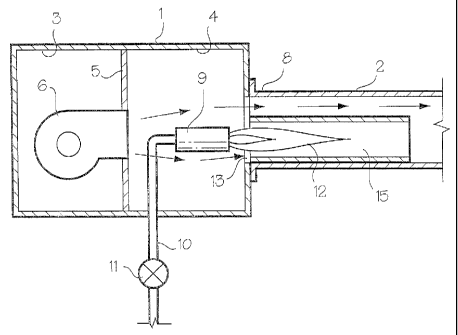Une partie des informations de ce site Web a été fournie par des sources externes. Le gouvernement du Canada n'assume aucune responsabilité concernant la précision, l'actualité ou la fiabilité des informations fournies par les sources externes. Les utilisateurs qui désirent employer cette information devraient consulter directement la source des informations. Le contenu fourni par les sources externes n'est pas assujetti aux exigences sur les langues officielles, la protection des renseignements personnels et l'accessibilité.
L'apparition de différences dans le texte et l'image des Revendications et de l'Abrégé dépend du moment auquel le document est publié. Les textes des Revendications et de l'Abrégé sont affichés :
| (12) Brevet: | (11) CA 2608038 |
|---|---|
| (54) Titre français: | ENSEMBLE GENERATEUR DE CHALEUR A TUBE RADIANT |
| (54) Titre anglais: | RADIANT TUBE HEATER ASSEMBLY |
| Statut: | Octroyé |
| (51) Classification internationale des brevets (CIB): |
|
|---|---|
| (72) Inventeurs : |
|
| (73) Titulaires : |
|
| (71) Demandeurs : |
|
| (74) Agent: | CASSAN MACLEAN IP AGENCY INC. |
| (74) Co-agent: | |
| (45) Délivré: | 2014-05-13 |
| (22) Date de dépôt: | 2007-10-17 |
| (41) Mise à la disponibilité du public: | 2008-05-17 |
| Requête d'examen: | 2012-10-03 |
| Licence disponible: | S.O. |
| (25) Langue des documents déposés: | Anglais |
| Traité de coopération en matière de brevets (PCT): | Non |
|---|
| (30) Données de priorité de la demande: | ||||||
|---|---|---|---|---|---|---|
|
Un appareil de chauffage à tube radiant comprend un logement et un tube de brûleur qui se prolonge vers l'extérieur de celui-ci pour transporter les produits de combustion hors du logement. Quand il faut moins de chaleur, à moins de réduire l'air de la soufflante, il y a trop d'air pour une combustion complète du combustible et l'excédent d'air se mélange avec les gaz de combustion, causant un refroidissement dans le tube du brûleur. Ce problème est résolu en fournissant un tube à flamme courte dans l'entrée du tube du brûleur pour recevoir la flamme. Le flot d'air excédentaire autour du tube de la flamme est chauffé. Ainsi, il est nécessaire de réduire seulement l'approvisionnement en combustible vers le brûleur.
A radiant tube heater includes a housing and a burner tube extending outwardly therefrom for carrying products of combustion from the housing. When less heat is required, unless air from the blower is reduced, there is too much air for complete combustion of the fuel and excess air mixes with combustion gases causing cooling in the burner tube. This problem is solved by providing a short flame tube in the inlet end of the burner tube for receiving the flame. Excess air flow around the flame tube is heated. Thus, it is necessary to reduce only the supply of fuel to the burner.
Note : Les revendications sont présentées dans la langue officielle dans laquelle elles ont été soumises.
Note : Les descriptions sont présentées dans la langue officielle dans laquelle elles ont été soumises.

Pour une meilleure compréhension de l'état de la demande ou brevet qui figure sur cette page, la rubrique Mise en garde , et les descriptions de Brevet , États administratifs , Taxes périodiques et Historique des paiements devraient être consultées.
| Titre | Date |
|---|---|
| Date de délivrance prévu | 2014-05-13 |
| (22) Dépôt | 2007-10-17 |
| (41) Mise à la disponibilité du public | 2008-05-17 |
| Requête d'examen | 2012-10-03 |
| (45) Délivré | 2014-05-13 |
Il n'y a pas d'historique d'abandonnement
Dernier paiement au montant de 236,83 $ a été reçu le 2023-10-11
Montants des taxes pour le maintien en état à venir
| Description | Date | Montant |
|---|---|---|
| Prochain paiement si taxe générale | 2024-10-17 | 624,00 $ |
| Prochain paiement si taxe applicable aux petites entités | 2024-10-17 | 253,00 $ |
Avis : Si le paiement en totalité n'a pas été reçu au plus tard à la date indiquée, une taxe supplémentaire peut être imposée, soit une des taxes suivantes :
Les taxes sur les brevets sont ajustées au 1er janvier de chaque année. Les montants ci-dessus sont les montants actuels s'ils sont reçus au plus tard le 31 décembre de l'année en cours.
Veuillez vous référer à la page web des
taxes sur les brevets
de l'OPIC pour voir tous les montants actuels des taxes.
Les titulaires actuels et antérieures au dossier sont affichés en ordre alphabétique.
| Titulaires actuels au dossier |
|---|
| VANCAK, JOHN |
| Titulaires antérieures au dossier |
|---|
| S.O. |